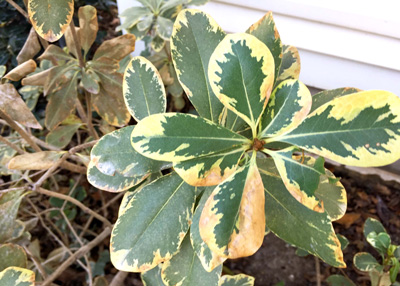Early Assessment of Cold Damage

Photo: This variegated pittosporum in my own landscape in rural Collin County will not survive. The leaves are browning quickly, and the stems will soon be soft and mushy. Maybe someday I’ll understand why I still bother to plant it as far north as we live.
This is the fourth time that I’ve started this story. Each time I’ve decided what I had written was too long and too complicated, so I’m going to shorten it down to just facts and strong suppositions.
Here are the reports I got back from my horticultural colleagues across Texas.
McKinney, where we live and where I garden, we saw 11 degrees Saturday morning. It was also 11 three weeks earlier.
San Angelo, where John Begnaud is the retired county Extension horticulturist – John says it went to 14 there.
Uvalde, from Extension Horticulture leader Dr. Larry Stein. Larry saw 16 there.
San Antonio, I heard from Bob Brackman, director of the San Antonio Botanic Gardens. He said it went to 14 there in December and 16 last Saturday.
San Antonio, from Dr. Jerry Parsons, retired specialist with Texas AgriLife Extension. Jerry told me it dropped to 20 in areas he checked, and did so for 5-8 hours each night.
El Campo, nurseryman Leon Macha said it fell to “around 20.”
College Station, my longtime friend, Extension horticulturist Dr. Bill Welch reported 15.
East Texas, south of Tyler, Extension horticulturist Greg Grant’s thermometer registered 14 at his farm.
Folks, those are crazy-similar temperatures way south into Texas, and based on what these men reported back to me and what I’ve seen on my Facebook page when I asked my FB friends to report in, here are my comments.
My comments based on all that I’ve heard:
• Don’t compare this winter to last winter. The current winter has already been unusually harsh. The winter of 2015/2016 was incredibly mild. Many people have said, “I just don’t understand why the plants froze last week. They made it through last winter just fine.” That’s the reason. This year has, so far, been 20 to 25 degrees colder.
• Don’t rush to judge the extent of the damage, especially with woody plants that may send out new leaves to replace frozen ones, also with perennials that normally freeze to the ground anyway. If shrubs’ stems are mushy or shriveled, they’re probably lost. But you’ll know with more certainty if you wait a couple of weeks.
• Live oaks and azaleas, among other evergreen plants, are shedding their old leaves unusually early due to the cold. But the plants themselves will be fine. Your waxleaf ligustrums may look like someone walked on them with hot cleats. They’ll rebound from that as new growth emerges in spring.
• “Hardy” citrus may or may not have been tough enough to survive this cold. Several of my horticultural friends mentioned this in detail. They are nervously watching the outcome. Definitely sit tight for a few weeks and let the plants themselves tell you. Their survival depends on the plants’ vigor, their placement within your landscape (for example, protection from the wind), how cold it got and how long it stayed below freezing.
• Tropical perennials may not come back. Shell gingers and Gold Star esperanzas are two good examples that suffered damage in South Texas. In North Texas, rosemary was probably lost, and Mexican bush sage could very well be gone as well. Elephant ears might be in jeopardy in some areas.
• Aspidistra (cast iron plant), ardisia and Asian jasmine may have frozen back to the ground in the northern half of the state, but if you’re patient, they’ll send out new growth come spring.

Photo: Holly ferns are supposed to be evergreen. I finally got my courage up and planted these out of their pots and into my DFW-area landscape (in a protected location!), but thanks to the cold, they’re toast. I didn’t lose many plants – I’ve been burned too many times.
• Pittosporums, Indian hawthorns, loquats, figs, fig ivy, gardenias, star jasmine and, for sure, oleanders were hurt in many parts of the state. Of the batch, fig ivy and oleanders will probably come back from their roots. The others could be wounded, or they may be lost.
• Pansies may have been set back too far to recover. Let them show you how vigorous they are by their regrowth over the next couple of weeks. Cabbage and kale have been lost in many areas.
So that’s a disappointing report for most of us who love gardening, but we can also use it as a chance to renew and refresh the plants in our gardens. Hope springs eternal!
Spring is going to be busy, and inventories of the most winter-hardy plants will be tested as people resolve not to make the same mistakes again. So my best advice to you would be to “shop early” and “shop wisely.”
